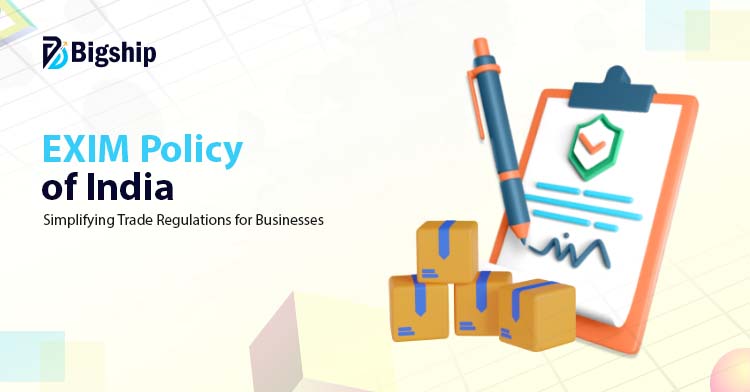Have you ever thought about how India regulates its exports and imports? The answer is through its EXIM policy. Export and import create new opportunities for businessmen and entrepreneurs, but the EXIM policy of India shapes the entire process. It controls how goods move across borders and ensures smooth transactions.
The current EXIM policy helps businesses follow trade rules. So let’s understand what is EXIM policy, its features, objectives, and many more things in this blog.
What Does the EXIM Policy of India Mean?
EXIM Policy of India sets the rules for how products and services move in and out of the country. Its main goal is to regulate and develop foreign trade while ensuring smooth import and export operations.
EXIM Policy of India, also referred as the Foreign Trade Policy, is regulated by the Foreign Trade and Development and Regulation Act of 1992. The Indian government announce the new EXIM policy in every five year. Each policy remains valid for five years, but changes, amendments, or new provisions are introduced every year on 31 March, taking effect from 1 April.
The bodies involved in drafting the EXIM Policy of India are the Ministry of Finance, the Directorate General of Foreign Trade (DGFT), and the Union Minister of Commerce and Industry. These bodies work together to modify and enhance the policy based on trade requirements.
It was in 2004 when the EXIM Policy was renamed the Foreign Trade Policy (FTP) to provide a broader and more structured approach to international trade. The most recent FTP, announced by the Ministry of Commerce, came into effect on 1 April 2023. Covering the period 2023-2028, this policy aims to make India a global export hub and strengthen its position in international trade.
Historical Background of EXIM Policy of India
Did you know that India’s trade policies were once very restrictive? In the 1950s and 1960s, the Indian government focused on self-sufficiency and self-reliance. The goal was to reduce dependence on imports and build a strong domestic economy. International trade wasn’t a priority, and strict rules controlled exports and imports.
Things started changing in the 1970s. That’s when the first EXIM policy in business environment was introduced. It was a three-year plan designed to boost exports. But trade was still limited, making it tough for businesses like yours to grow globally.
The biggest shift came in 1991, a time known as the post-reform period. India moved away from restrictive policies and opened its doors to global trade. The EXIM Policy of India was revised to allow export and trading houses to import goods. For the first time, businesses could have 51% foreign equity which created more trade opportunities.
For instance, in 1994-95, the government introduced Super Star Trading Houses. These trading houses received special benefits, like access to top consultative bodies that influenced trade policies. This gave businesses like yours a stronger voice in shaping India’s trade environment.
Another major step came in 2001-02 with the launch of the Market Access Initiative Scheme. This helped Indian businesses expand internationally by offering detailed market research on product demand in different countries.
Over the years, the EXIM Policy of India has evolved to support businesses like yours. Every reform has opened new doors, making it easier for you to trade internationally and grow in the global market.
Objectives of EXIM Policy of India
If you’re in business, you must have better understanding of the objectives of the EXIM policy of India. Let’s understand these objectives in a detailed manner.
- The main goal of the EXIM Policy is to boost India’s exports. By supporting businesses that sell goods and services abroad, the policy helps the country earn foreign exchange and strengthen its economy.
- Foreign trade brings in foreign currency, which is vital for the country’s economic stability. The EXIM Policy ensures that India earns more through exports while balancing its imports.
- India aims to expand its export basket, rather than relying on a few products. This means supporting different industries, whether it’s textiles, electronics, or pharmaceuticals, so that the country has multiple sources of trade revenue.
- For Indian businesses to succeed globally, they need better access to international markets. The EXIM Policy simplifies procedures by making it easier for exporters to connect with buyers worldwide.
- It’s not just about exporting more, it’s also about exporting better. The EXIM policy encourages the export of high-value and technologically advanced products that can compete in the global market.
- India focuses on expanding trade with emerging economies instead of depending only on traditional trading partners. This reduces risks and opens up new opportunities for businesses.
- SMEs are the backbone of India’s economy, and the EXIM Policy helps them grow by providing financial assistance, subsidies, and simplified trade regulations.
- A strong trade infrastructure, such as better ports, logistics, and export hubs, makes international trade smoother. The EXIM policy ensures investment in these areas to support exporters.
- The EXIM policy of India aims to streamline trade processes, that includes complicated paperwork, thus making it easier and faster for companies to export and import goods.
- The government encourages exports by offering financial benefits like tax exemptions, subsidies, and special schemes that reduce costs for businesses.
- For Indian goods to compete globally, they must meet international quality standards. The policy promotes quality control and certification to ensure that exported goods meet global expectations.
- The policy supports research and development (R&D) so that Indian businesses can create better, more competitive products for export.
- Foreign investment is essential to make India a global trade hub. Our EXIM policy attracts foreign companies to invest in Indian industries, strengthening exports and boosting economic growth.
- Agriculture plays a big role in India’s economy. The EXIM Policy helps farmers and food businesses by promoting the export of agricultural and processed food products.
- Diplomatic and trade relationships with other countries help businesses expand globally. The policy works towards strengthening India’s trade ties with different nations.
- Online trade is booming, and India is tapping into this opportunity. The policy supports e-commerce exports which allows businesses to sell their products globally through digital platforms.
- The policy promotes eco-friendly trade practices and encourages businesses to adopt sustainable methods in exports, with growing concerns about the environment.
- Apart from exports, the EXIM policy ensures that India imports essential goods like medical equipment, energy resources, and advanced technology to support domestic industries and consumers.
- India is a leader in IT, tourism, and healthcare services, and the EXIM policy encourages these sectors to expand their global presence.
- Ultimately, the EXIM Policy aims to make Indian industries remain a strong player in international trade.
Features of the Present EXIM Policy of India
The EXIM Policy of India plays a crucial role in guiding the export and import activities of the country. The policy features various initiatives that support businesses and exporters while encouraging trade. Here’s a more detailed explanation of some of the key features of the new EXIM policy of India (2023-2028):
Process Re-Engineering and Automation: The EXIM policy aims to simplify the export process by introducing more technology and automation. For instance, schemes like EPCG (Export Promotion Capital Goods) and Advance Authorisation will continue, but they will be enhanced with technological upgrades to ease the exporter’s workload. This shift will not only save time but also improve efficiency in the export ecosystem.
Towns of Export Excellence: The EXIM policy designates specific towns as Towns of Export Excellence (TEE). This year, towns like Mirzapur, Faridabad, Varanasi, and Moradabad have been added to this list. These towns get priority access to export promotion funds under the MAI (Market Access Initiative) scheme. This policy encourages the development of these towns as strong export hubs.
Recognition of Exporters: Exporter firms that perform well are recognized and can play a role in building the capacity of others. Firms that hold a two-star or higher status are encouraged to share their knowledge and provide trade-related training. This initiative aims to boost export awareness and help create an ecosystem of skilled exporters, which strengthens the entire export sector.
Promoting Exports from Districts: The policy also promotes district-level exports, encouraging state governments to support smaller and local exporters. The Districts as Export Hubs (DEH) initiative is part of this effort that aims to stimulate export activity in various regions and accelerate grassroots development. This approach helps build a strong local trade network so that even smaller and remote areas can contribute to India’s overall export growth.
Streamlining SCOMET Policy: The SCOMET (Special Chemicals, Organisms, Materials, Equipment, and Technologies) policy is aimed at regulating the export of specific high-end technologies, materials, and chemicals that have dual uses. This policy has been made more comprehensive, ensuring better control over the export of sensitive goods.
Facilitating e-commerce Exports: The policy lays down a roadmap for supporting e-commerce exports. It aims to set up e-commerce hubs and address key issues like bookkeeping, returns policy, and payment reconciliation for e-commerce businesses.
Rationalization of the EPCG Scheme: The EPCG scheme allows exporters to import capital goods (machinery, equipment, etc.) at zero customs duty for producing goods meant for export. Under the new EXIM policy, this scheme is being further streamlined and improved. The inclusion of the PM MITRA (Prime Minister Mega Integrated Textile Region and Apparel Parks) scheme adds new opportunities for exporters in the textile industry to claim benefits under this scheme.
Dairy Sector Exemption: The dairy sector has been exempted from maintaining the average export obligation, which is typically required under the EPCG scheme. This exemption aims to help the dairy industry by allowing them to upgrade their technology without being burdened by export obligations. In addition to dairy, other sectors like vertical farming, battery electric vehicles (BEV), and green technologies also benefit from reduced export obligations under the EPCG scheme.
Facilitation Under the Advance Authorisation Scheme: The Advance Authorisation Scheme allows exporters to import raw materials duty-free to manufacture goods for export. This scheme has been enhanced in the new policy to support industry needs and Export Promotion Councils. This provision is particularly helpful for manufacturers as it reduces their operational costs and supports them in boosting exports.
Merchanting Trade: Merchanting trade is a type of trade where goods are shipped directly from one foreign country to another, bypassing India. Indian businesses can act as intermediaries in such transactions, which is beneficial for trade, especially with countries that are involved in significant global trade hubs like Singapore, Dubai, and Hong Kong.
Amnesty Scheme: The Amnesty Scheme is a one-time provision introduced to help exporters who are unable to meet their obligations under the EPCG and Advance Authorisation schemes. This scheme gives relief to those who have defaulted in the past by reducing the penalties they owe. Exporters will only need to pay the duties and interest at 100% of the exempted duties.
What Are the Advantages of EXIM Policy?
The EXIM Policy (Export-Import Policy) is designed to make international trade easier and more beneficial for businesses and consumers. Here are its key advantages:
Simplifies Trade Through Technology: The policy promotes digitization and automation which makes import and export processes faster and simpler. This helps businesses complete transactions smoothly and focus on growing their trade.
Expand Global Market Opportunities: It allows Indian businesses to enter international markets, increasing sales and profits. This global reach helps Indian products compete on a larger scale.
Boosts India’s Economy: By encouraging exports, the EXIM Policy contributes to India’s Gross Domestic Product (GDP) growth. More exports mean more revenue and economic stability.
Brings More Foreign Currency into India: When Indian companies sell goods internationally, they earn foreign currency, which strengthens India’s economy and improves trade relations with other countries.
Encourages Free Trade and Market Growth: The policy reduces trade barriers, making it easier for businesses to import essential goods and export surplus products.
Provides Quality Goods at Competitive Prices: With easier imports, domestic consumers get access to high-quality international products at affordable prices. Similarly, Indian manufacturers can use better raw materials to improve their products.
About EXIM Bank of India
So far, you have learned about the EXIM Policy of India. Now, let’s understand EXIM Bank of India, the financial institution that makes global trade easier for businesses.
The EXIM Bank of India was established on January 1, 1982, and plays a crucial role in supporting businesses engaged in international trade. It was created to take over the global finance operations of the Industrial Development Bank of India (IDBI) and provide financial assistance to exporters and importers.
It offers funding for various trade-related activities, including export production, import of advanced technology, and export product development. Whether it’s pre-shipment, post-shipment finance, export marketing, or overseas investments, the bank helps businesses grow beyond borders. If you’re a business looking to expand globally, EXIM Bank can be a valuable partner.
Conclusion
The current EXIM policy is your gateway to global trade. It simplifies exports and imports, making it easier for businesses like yours to grow internationally. The EXIM policy offers you financial support, market access, and trade benefits that help you compete worldwide.
Whether you’re new to exports or looking to expand your business, understanding this policy can open new doors for you. Stay informed, make the most of these opportunities, and take your business to the global stage!
FAQs
What is the present EXIM policy of India?
The present EXIM policy of India (2023-28) focuses on trade facilitation, e-commerce exports, and reducing export obligations. It aims to make Indian businesses globally competitive with digital processes and financial support.
Who regulates the EXIM policy of India?
The EXIM policy of India is regulated by the Foreign Trade and Development and Regulation Act of 1992.
Is the EXIM policy of India permanent?
No, the EXIM policy of India changes every five years. The current EXIM policy of India is valid from 2023 to 2028.





